|
Introduced in September 1975 the Jaguar XJS was intended to be a direct replacement for the E-type.
Plans for this model began long before itís actual introduction. A memo from Malcolm Sayer, the legendary Jaguar aerodynamicist, to Jaguar founder
Sir William Lyons, in September 1968 described the new vehicle. The note outlined an automobile that should be a low, wide and high-speed car matching
the design of those created by Italian manufacturers, even if it meant sacrificing silence, ease of entry and interior space.
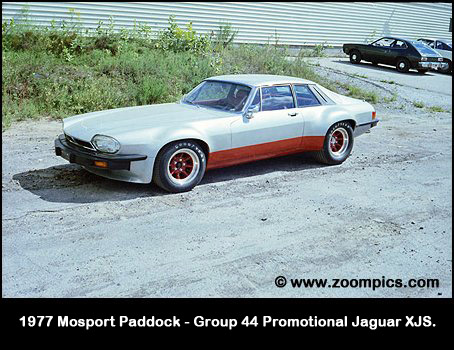 The body design for this car was by Lyons and Sayer, with extensive wind tunnel testing carried out to
perfect the car's aerodynamics. Utilizing the already proven mechanics of the XJ sedan minimized development costs. The front suspension of the XJS
used a fully independent semi-trailing wishbone and coil spring set-up. The rear suspension was also independent with lower traverse wishbones and
the half shafts acting as the upper links. Twin rear springs and shock absorbers were also incorporated into the rear suspension design. To stop
the car, British Leyland fitted power assisted disc Brakes - vented rotors with 4-piston calipers on the front and on the rear solid rotors with 2-piston
calipers. The steering system was a power-assisted rack and pinion with three rotations required to turn lock to lock. The car was equipped with 15-inch
wheels and the original tires were 205/70VR15. Perhaps the most impressive feature of the car was the motor. The XJS used an aluminum overhead cam V12.
The 326 cubic inch engine used a Bosch-Lucas electronic manifold fuel injection system, which produced 285-horsepower at 5800 rpm. When coupled with
the handling characteristics and comfort of the advanced suspension, performance was said to equal that of the E-type.
The body design for this car was by Lyons and Sayer, with extensive wind tunnel testing carried out to
perfect the car's aerodynamics. Utilizing the already proven mechanics of the XJ sedan minimized development costs. The front suspension of the XJS
used a fully independent semi-trailing wishbone and coil spring set-up. The rear suspension was also independent with lower traverse wishbones and
the half shafts acting as the upper links. Twin rear springs and shock absorbers were also incorporated into the rear suspension design. To stop
the car, British Leyland fitted power assisted disc Brakes - vented rotors with 4-piston calipers on the front and on the rear solid rotors with 2-piston
calipers. The steering system was a power-assisted rack and pinion with three rotations required to turn lock to lock. The car was equipped with 15-inch
wheels and the original tires were 205/70VR15. Perhaps the most impressive feature of the car was the motor. The XJS used an aluminum overhead cam V12.
The 326 cubic inch engine used a Bosch-Lucas electronic manifold fuel injection system, which produced 285-horsepower at 5800 rpm. When coupled with
the handling characteristics and comfort of the advanced suspension, performance was said to equal that of the E-type.
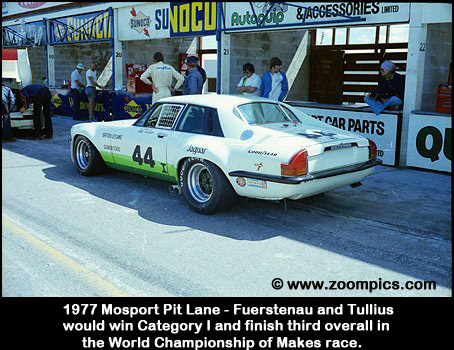 Traditionally, British Leyland had used racing to raise the public's interest in their products.
In North America during the early '70s, the Jaguar E-type was campaigned on the east coast by Bob Tullius, whose team, Group 44, had successfully
entered Triumph and MG sports cars in Sports Car Club of America (SCCA) races. Joe Huffaker, who had also been successful with MGs over the years,
entered a similar model on the west coast with Lee Mueller as his driver. In 1975, Tullius used the E-type to win the SCCA B Production National
Championship. Unfortunately, production of this model ceased towards the end of 1974. As a result, it was difficult to justify the E-type racing
program as a marketing tool to sell more cars.
Traditionally, British Leyland had used racing to raise the public's interest in their products.
In North America during the early '70s, the Jaguar E-type was campaigned on the east coast by Bob Tullius, whose team, Group 44, had successfully
entered Triumph and MG sports cars in Sports Car Club of America (SCCA) races. Joe Huffaker, who had also been successful with MGs over the years,
entered a similar model on the west coast with Lee Mueller as his driver. In 1975, Tullius used the E-type to win the SCCA B Production National
Championship. Unfortunately, production of this model ceased towards the end of 1974. As a result, it was difficult to justify the E-type racing
program as a marketing tool to sell more cars.
Despite Jaguar's history and success with their racing programs Lord Stokes of British Leyland had shown
no interest in getting the XJS on the track. But in the U.S., Michael H. Dale, British Leyland's Vice President of sales, remained an enthusiastic
supporter of racing as a promotional tool. Even if the head office didn't want to see the XJS out on the tracks, he did, and it was Dale who worked
closely with Bob Tullius to have the Group 44 XJS program replace that of the E-type V12 development.
The first race for the new car was in July 1976 at Watkins Glen, but with poor weather Tullius decided to
wait until the August Trans Am race at Mosport. At the Mosport event, he captured the pole and turned the fastest lap and led for over half the race.
However, he discovered that when running in traffic there was insufficient ducting for the oil cooler. With the oil temperature rising rapidly he had
to run in clean air and could not get involved in any close racing. In the end, Tullius had to back off and finish Tenth overall and fourth in Category I.
The next test for the car was an IMSA Camel GT race at Daytona. Tullius was running fourth at the halfway point, however, he was forced to retire
when the car's interior temperature became unbearable.
The exploratory outings at Mosport and Daytona showed the car's potential and a full season was planned.
At the time, Dale said that Group 44 had demonstrated its capability to enter professional racing and that British Leyland had a car, which would
be competitive in a professional series. It was decided that Tullius would focus on the 1977 Trans Am series with no plans for him to enter SCCA
National competition. The company maintained its involvement in amateur racing through Huffaker Engineering, which ran a Triumph TR7 and MGB at
National events and Group 44 that entered a TR7 for Brian Fuerstenau. It is interesting to note that the XJS was not eligible for competition at the
international level in Europe until 1982 when Group A for four seaters was introduced. Entered by Tom Walkinshaw, the TWR-Motul sponsored XJS team won
four major races in 1982.
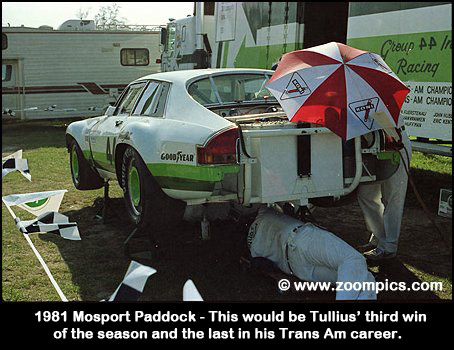 The main responsibility for developing this car belonged to Brian Fuerstenau, Group 44's engineer and
Latton 'Lanky' Fouchee the team's chief mechanic. Turning the XJS into a Trans Am prepared racer used many of the standard practices for cars built
during this period. Tube frame cars were not introduced to the Trans Am rule book until 1980, so the process began with a shell stripped to bare metal.
Next, the roll cage was installed with the team ensuring that it was positioned to stiffen the chassis. The suspension went through the usual
modifications. To eliminate bump steer, the steering arms were bent to shorten the distance between them and the steering rack. The power steering was
retained but a larger pulley was installed on the pump to compensate for the higher revving engine. Any rubber used in the suspension was replaced with
solid bushings. The car was also equipped with heavier springs and roll-bars. There were also modifications made to front and rear suspension arms to
improve strength and increase tire clearance.
The main responsibility for developing this car belonged to Brian Fuerstenau, Group 44's engineer and
Latton 'Lanky' Fouchee the team's chief mechanic. Turning the XJS into a Trans Am prepared racer used many of the standard practices for cars built
during this period. Tube frame cars were not introduced to the Trans Am rule book until 1980, so the process began with a shell stripped to bare metal.
Next, the roll cage was installed with the team ensuring that it was positioned to stiffen the chassis. The suspension went through the usual
modifications. To eliminate bump steer, the steering arms were bent to shorten the distance between them and the steering rack. The power steering was
retained but a larger pulley was installed on the pump to compensate for the higher revving engine. Any rubber used in the suspension was replaced with
solid bushings. The car was also equipped with heavier springs and roll-bars. There were also modifications made to front and rear suspension arms to
improve strength and increase tire clearance.
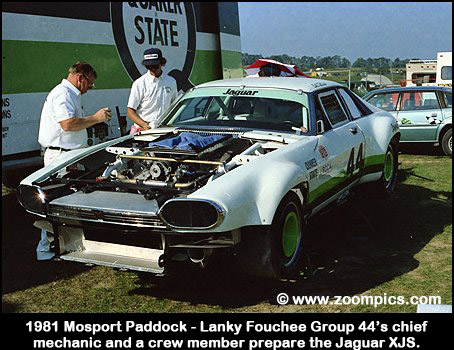 While the standard XJS braking system may have seemed remarkable for cars produced during the late '70s,
Group 44 utilized an even more impressive set-up. Their Trans Am car was fitted with Lockheed rotors and 8-piston calipers on the front. The rear used
the front calipers from an E-type and Girling rotors. Despite the use of these superior brake components the car was fitted with a single master cylinder
from a Ford pickup truck.
While the standard XJS braking system may have seemed remarkable for cars produced during the late '70s,
Group 44 utilized an even more impressive set-up. Their Trans Am car was fitted with Lockheed rotors and 8-piston calipers on the front. The rear used
the front calipers from an E-type and Girling rotors. Despite the use of these superior brake components the car was fitted with a single master cylinder
from a Ford pickup truck.
Group 44 had always prided themselves on superior handling cars rather than horsepower. The engine
received only a few modifications. Pistons, camshafts, engine bolts and valve springs were replaced with aftermarket performance pieces. The area of
the engine receiving the most attention was the oiling system. A dry sump arrangement was employed which included a Weaver Pump and 7.5-gallon oil tank
to lubricate the seven main and twelve rod bearings. The original fuel injection system was replaced with a new manifold and six twin-choke Weber
carburetors. The early race engines were said to produce 475 horsepower a far cry from the 285 listed in their sales brochures. Before the end of the
first season the car was producing 540 horsepower.
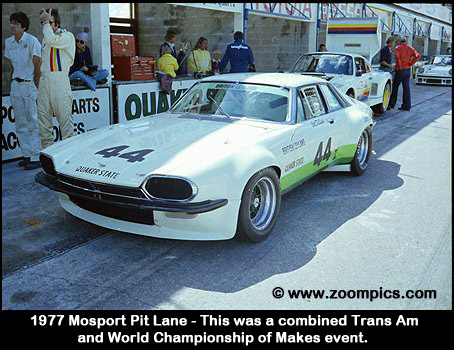 North American XJS's were only available with a Borg Warner 3-speed automatic transmission obviously not
suitable for racing. However, the team was able to use the 4-speed manual transmission available in European versions of the model. Although a limited
slip differential was a standard feature on the Jaguar, Group 44 chose to weld it for competition.
The final product was a very competitive Trans Am race car that generated 1 g. of lateral acceleration and with the right final drive would exceed
180 mph in 4th gear.
North American XJS's were only available with a Borg Warner 3-speed automatic transmission obviously not
suitable for racing. However, the team was able to use the 4-speed manual transmission available in European versions of the model. Although a limited
slip differential was a standard feature on the Jaguar, Group 44 chose to weld it for competition.
The final product was a very competitive Trans Am race car that generated 1 g. of lateral acceleration and with the right final drive would exceed
180 mph in 4th gear.
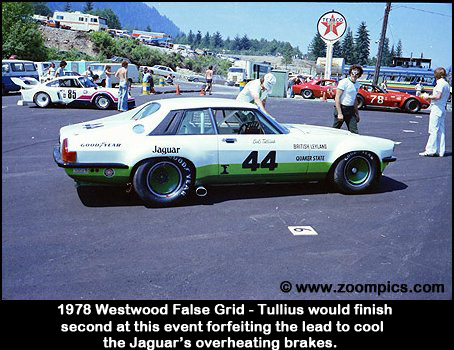 Aside from the 1976 event at Mosport, 1977 wasn't Tullius' first foray into Trans Am competition. In fact,
he had won the over two-liter class in the first Trans Am race held at Sebring in 1966 using a Dodge Dart that he shared with Tony Adamowicz. He also
won a Trans Am event the following year at Daytona. In 1971, he caught the attention of the media and fans when he entered a 1964 Pontiac against factory
supported Mustangs, Camaros and Javelins. The E-type was also used in a Trans Am event at Brainerd in 1975. He qualified second but a broken axle
relegated him to a sixteenth place finish. But the 1977 season proved to be the first year that Group 44 would devote their efforts to both the Trans
Am Driver and Manufacturer championships for British Leyland.
Aside from the 1976 event at Mosport, 1977 wasn't Tullius' first foray into Trans Am competition. In fact,
he had won the over two-liter class in the first Trans Am race held at Sebring in 1966 using a Dodge Dart that he shared with Tony Adamowicz. He also
won a Trans Am event the following year at Daytona. In 1971, he caught the attention of the media and fans when he entered a 1964 Pontiac against factory
supported Mustangs, Camaros and Javelins. The E-type was also used in a Trans Am event at Brainerd in 1975. He qualified second but a broken axle
relegated him to a sixteenth place finish. But the 1977 season proved to be the first year that Group 44 would devote their efforts to both the Trans
Am Driver and Manufacturer championships for British Leyland.
The 1977 Trans Am championship for Category I and II cars consisted of 11 races. The XJS was entered in
the Category I class. The automobiles in this class were not as highly modified as those in Category II. Tullius started the season with wins at the
first two races, Seattle and Westwood. But a DNF at Portland and an eighth place finish at Nelson Ledges allowed John Bauer in a Porsche 911 SC to take
the points lead. The fifth race of the series was a 6-hour event at Watkins Glen, which was run in conjunction with the World Championship for Makes.
Double points were awarded for Trans Am competitors due to the race length and to encourage teams to enter the event. Brian Fuerstenau was brought in
to share the driving duties with Tullius. The pair qualified twenty-first overall and 1st in class, which resulted in some satisfaction for the team
as the car was detuned for reliability. Tullius joked that these changes were made so that the car would last for five hours and fifteen minutes.
Unfortunately, his words proved prophetic as a combination of a broken wheel and electrical problems resulted in a fourth place finish. Tullius' main
rival for the championship, Bauer, finished second, which allowed him to maintain his points lead. After the Glen, Group 44 returned to their early
season form and the team took three wins in the remaining six races, finishing out of the top three once. In the end, Tullius won the Driver's
Championship with 170 points to Bauer's 162. Despite this success and Jaguar's five wins to Porsche's three the team fell just 2 points short of the
Manufacturer's title. It was inevitable that Porsche would win this title as three, of the top four competitors in the Driver's championship raced
this marque. The disappointment of not achieving this goal was not lost on Group 44 for next season.
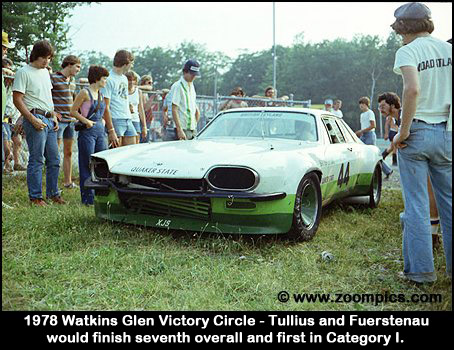 For 1978 a new lighter car was built and fitted with a 560 horsepower engine. The opening round took place
at Sears Point. That year's series did not begin with the success the team had experienced in 1977. Tullius finished ninth in the first race but the
results improved with a second at Westwood and a third at Portland. However, after these first three races, he found himself second in the standings to
Corvette driver Babe Headley. But at the fourth race of the season, St. Jovite, Group 44 and Tullius started a streak, winning seven of the remaining
races in the series. Tullius captured his second straight Category I Driver's Championship with 189 points. In fact, he finished 90.5 points in front
of his closest rival, Headley, claiming the championship long before the end of the season. The Driver's championship was one of the team's goals and
the second was to win the Manufacturer's title. To accomplish this, the 1977 model was entered for Brian Fuerstenau, in the last three events. Fuerstenau
had a DNF at Road America but took a third at Laguna Seca and an eighth at Mexico City. He finished the season fourth in the Driver standings as a
combination of these late season finishes and a win he shared with Tullius at Watkins Glen. The efforts of Fuerstenau and Tullius gave Jaguar 73 points
to Chevrolet's 69 in the manufacturer's segment of the Trans Am championship. Group 44 had achieved the two objectives set in 1976.
For 1978 a new lighter car was built and fitted with a 560 horsepower engine. The opening round took place
at Sears Point. That year's series did not begin with the success the team had experienced in 1977. Tullius finished ninth in the first race but the
results improved with a second at Westwood and a third at Portland. However, after these first three races, he found himself second in the standings to
Corvette driver Babe Headley. But at the fourth race of the season, St. Jovite, Group 44 and Tullius started a streak, winning seven of the remaining
races in the series. Tullius captured his second straight Category I Driver's Championship with 189 points. In fact, he finished 90.5 points in front
of his closest rival, Headley, claiming the championship long before the end of the season. The Driver's championship was one of the team's goals and
the second was to win the Manufacturer's title. To accomplish this, the 1977 model was entered for Brian Fuerstenau, in the last three events. Fuerstenau
had a DNF at Road America but took a third at Laguna Seca and an eighth at Mexico City. He finished the season fourth in the Driver standings as a
combination of these late season finishes and a win he shared with Tullius at Watkins Glen. The efforts of Fuerstenau and Tullius gave Jaguar 73 points
to Chevrolet's 69 in the manufacturer's segment of the Trans Am championship. Group 44 had achieved the two objectives set in 1976.
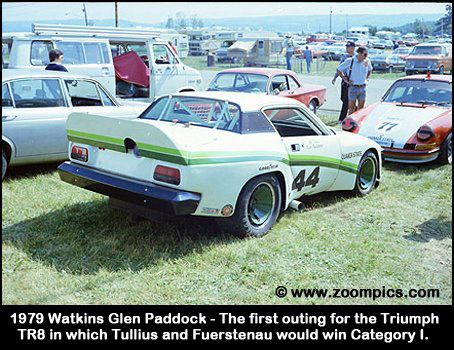 In the late Ď70s, British Leyland had been rallying an experimental Triumph TR7 with a V8 engine.
In late 1978 a decision was made by the company to put this car into production for 1979 and call it the Triumph TR8. As the result of its connection
with the factory, Group 44 was handed the task of turning the new vehicle into a racer. This meant parking the Jaguar XJS. The Triumphís first race
was Watkins Glen and despite no testing and few spare parts the team won Category I by a margin of almost 10-laps. But the TR8ís dominating win received
criticism from competitors who claimed the car was illegal. In addition to this controversy, British Leyland was unable to coordinate their marketing
program with the carís early success as production delays and labor problems had pushed back the introduction of the car. The TR8 only raced two
more times in the series but won both events. In the end, Tullius and Triumph finished second in their respective championships. For the 1980 season,
Group 44 and their TR8 moved to the IMSA GTO championship. Several factors contributed to the jump from SCCA to IMSA. The Trans Am had lacked direction
and leadership in 1979 and the team felt changes in the rules for 1980 were moving in the direction of amateurism. Furthermore, the IMSA series enjoyed
tremendous media coverage during the late Ď70s. By the end of the season Tullius had finished second in the Driver standings and his co-driver Bill Adam
fourth.
In the late Ď70s, British Leyland had been rallying an experimental Triumph TR7 with a V8 engine.
In late 1978 a decision was made by the company to put this car into production for 1979 and call it the Triumph TR8. As the result of its connection
with the factory, Group 44 was handed the task of turning the new vehicle into a racer. This meant parking the Jaguar XJS. The Triumphís first race
was Watkins Glen and despite no testing and few spare parts the team won Category I by a margin of almost 10-laps. But the TR8ís dominating win received
criticism from competitors who claimed the car was illegal. In addition to this controversy, British Leyland was unable to coordinate their marketing
program with the carís early success as production delays and labor problems had pushed back the introduction of the car. The TR8 only raced two
more times in the series but won both events. In the end, Tullius and Triumph finished second in their respective championships. For the 1980 season,
Group 44 and their TR8 moved to the IMSA GTO championship. Several factors contributed to the jump from SCCA to IMSA. The Trans Am had lacked direction
and leadership in 1979 and the team felt changes in the rules for 1980 were moving in the direction of amateurism. Furthermore, the IMSA series enjoyed
tremendous media coverage during the late Ď70s. By the end of the season Tullius had finished second in the Driver standings and his co-driver Bill Adam
fourth.
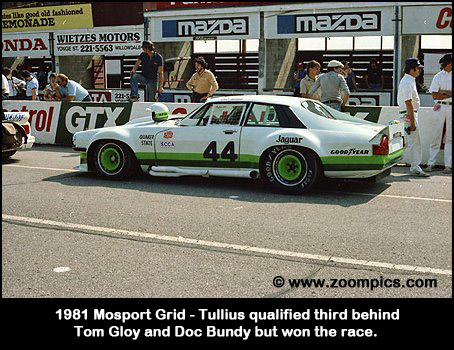 Returning after a two-year sabbatical Group 44 entered a much different and revitalized Trans Am championship.
The two class system of Category I and II cars had been eliminated. The SCCA dropped the exotic and expensive Category II in favor of a series that more
closely resembled the Category I cars. From a technological standpoint, the greatest change in the rules was the introduction of the tube frame chassis.
The XJS appearing in the 1981 season was not one of the two Jaguars, which Tullius drove in 1977 and '78 but a new car. Group 44 began construction on
the car at their Herndon, Virginia shop in late February. The XJS was built to the new chassis rules and unlike its predecessors used relatively few
Jaguar components. As is the case with many of today's Trans Am cars the only original manufacturer's parts were some body panels, trim and the engine.
The car was completed just in time for the series opener in May at Charlotte. The first time the car moved under its own power was in the paddock at this
event. The car was impressive in its debut finishing second to Eppie Wietzes in a Corvette. During the 1981 season, Tullius took victories at Portland,
Brainerd and Mosport. But for Tullius, it was an all or nothing season. His second at Charlotte and a fifth at Laguna Seca were his only other top 10
finishes. On the other hand, Weitzes only won one other Trans Am race during the 1981 championship, but his consistency earned him the title. It was Lime
Rock that proved to be the turning point of the season as the two drivers entered the event tied in the standings. Weitzes had his worst finish, seventh,
but Tullius was a DNF with an ignition failure. This round was followed by Road America where Tullius had another poor finish that allowed Wietzes to
build on a points lead he wouldn't relinquish. Despite the disappointment of not winning the Driver or Manufacturer championships the XJS had been very
competitive as Tullius had the most wins and secured his second place in the final standing by Laguna Seca, the penultimate round.
Returning after a two-year sabbatical Group 44 entered a much different and revitalized Trans Am championship.
The two class system of Category I and II cars had been eliminated. The SCCA dropped the exotic and expensive Category II in favor of a series that more
closely resembled the Category I cars. From a technological standpoint, the greatest change in the rules was the introduction of the tube frame chassis.
The XJS appearing in the 1981 season was not one of the two Jaguars, which Tullius drove in 1977 and '78 but a new car. Group 44 began construction on
the car at their Herndon, Virginia shop in late February. The XJS was built to the new chassis rules and unlike its predecessors used relatively few
Jaguar components. As is the case with many of today's Trans Am cars the only original manufacturer's parts were some body panels, trim and the engine.
The car was completed just in time for the series opener in May at Charlotte. The first time the car moved under its own power was in the paddock at this
event. The car was impressive in its debut finishing second to Eppie Wietzes in a Corvette. During the 1981 season, Tullius took victories at Portland,
Brainerd and Mosport. But for Tullius, it was an all or nothing season. His second at Charlotte and a fifth at Laguna Seca were his only other top 10
finishes. On the other hand, Weitzes only won one other Trans Am race during the 1981 championship, but his consistency earned him the title. It was Lime
Rock that proved to be the turning point of the season as the two drivers entered the event tied in the standings. Weitzes had his worst finish, seventh,
but Tullius was a DNF with an ignition failure. This round was followed by Road America where Tullius had another poor finish that allowed Wietzes to
build on a points lead he wouldn't relinquish. Despite the disappointment of not winning the Driver or Manufacturer championships the XJS had been very
competitive as Tullius had the most wins and secured his second place in the final standing by Laguna Seca, the penultimate round.
The XJS project was credited with boosting Jaguar sales when British Leyland's reputation in the U.S. was
approaching an all-time low. After three seasons, 1977-78 and 81, Bob Tullius had driven the XJS in 30 races and won 3 outright and achieved 12 Category
1 victories. His success in the XJS contributed in part to him being the first recipient of the Sir William Lyons International Jaguar Trophy. However,
the program had run its course and British Leyland's principals in America were working on a new plan. So after one Manufacturer and two Driver
championships, a new race car was created by Group 44, with Jaguar backing to replace the XJS program. The result was the XJR-5 penned by Lee Dykstra
using the venerable V12 engine designed to compete in the IMSA GTP endurance racing series.
|

